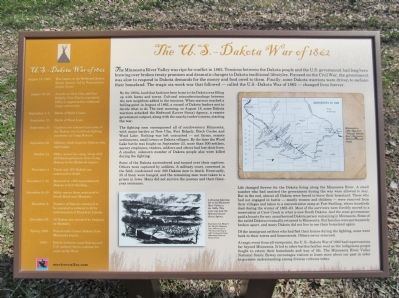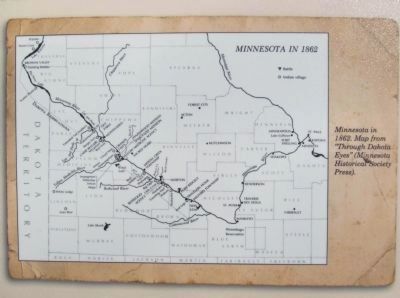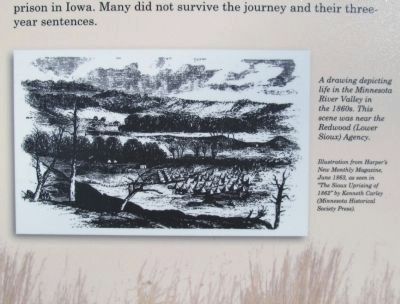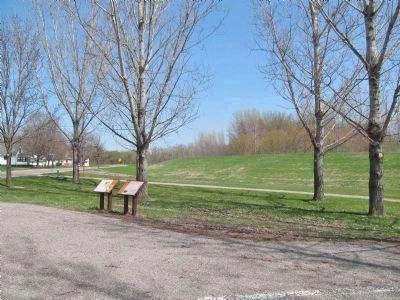Henderson in Sibley County, Minnesota — The American Midwest (Upper Plains)
The U.S.–Dakota War of 1862
The Minnesota River Valley was ripe for conflict in 1862. Tensions between the Dakota people and the U.S. government had long been brewing over broken treaty promises and dramatic changes to Dakota traditional lifestyles. Focused on the Civil War, the government was slow to respond to Dakota demands for the money and food owed to them. Finally, some Dakota warriors were driven to reclaim their homeland. The tragic six-week war that followed — called the U.S.–Dakota War of 1862 — changed lives forever.
By the 1860s, land that had once been home to the Dakota was filling up with farms and towns. Cultural misunderstandings between the new neighbors added to the tensions. When matters reached a boiling point in August of 1862, a council of Dakota leaders met to decide what to do. The next morning, on August 18, some Dakota warriors attacked the Redwood (Lower Sioux) Agency, a remote government outpost, along with the nearby trader’s stores, starting the war.
The fighting soon encompassed all of southwestern Minnesota, with major battles at New Ulm, Fort Ridgely, Birch Coulee and Wood Lake. Nothing was left untouched — not farms, remote settlements, small towns or Dakota villages. By the time the Wood Lake battle was fought on September 23, more than 500 settlers, agency employees, traders, soldiers and others had lost their lives. A smaller, unknown number of Dakota people also were killed during the fighting.
Some of the Dakota surrendered and turned over their captives. Others were captured by soldiers. A military court, convened in the field, condemned over 300 Dakota men to death. Eventually, 38 of them were hanged, and the remaining men were taken to a prison in Iowa. Many did not survive the journey and their three-year sentences.
Life changed forever for the Dakota living along the Minnesota River. A small number who had assisted the government during the war were allowed to stay. But in the end, almost all Dakota were forced to leave their homeland. Those who had not engaged in battle — mostly women and children — were removed from their villages and taken to a concentration camp at Fort Snelling, where hundreds died during the winter of 1862–63. Most of the survivors were forcibly moved to a reservation at Crow Creek in what is now South Dakota. And the state government paid a bounty for any unauthorized Dakota person remaining in Minnesota. Some of the exiled Dakota eventually returned to Minnesota. But families were permanently broken apart, and many Dakota did not live to see their homeland again.
Of the immigrant settlers who had fled their homes during the fighting, some went back to their towns and homesteads. Others never returned.
A tragic event from all viewpoints, the U. S.–Dakota War of 1862 had repercussions far beyond Minnesota. It led to other battles farther west as the indigenous people fought to retain their homelands and way of life. The Minnesota River Valley National Scenic Byway encourages visitors to learn more about our past in order to promote understanding among diverse cultures today.
U.S.-Dakota War of 1862
• August 18, 1862 War begins at the Redwood (Lower Sioux) Agency, led by Taoyateduta (Little Crow).
• August 19−25 Attacks on New Ulm and Fort Ridgely; New Ulm is evacuated. Sibley is appointed to command troops and scouts.
• September 1–2 Battle of Birch Coulee.
• September 23 Battle of Wood Lake.
• September 26 Captives are released and some of the Dakota who had been fighting surrender at Camp Release.
• September 28 Military trials begin for Dakota who had fought.
• October 24 Sibley moves his camp, along with all Dakota prisoners, from Camp Release to the Redwood Agency.
• November 4 Trials end; 303 Dakota are sentenced to death.
• November 7–13 Removal of 1,658 noncombatant Dakota to Fort Snelling.
• November 9−10 Sibley moves those sentenced to South Bend near Mankato.
• December 6 Number of Dakota sentenced to be executed is reduced to 40 by authorization of President Lincoln.
• December 26 38 Dakota are executed by hanging at Mankato.
• Spring, 1863 Forced exile of most Dakota from Minnesota begins.
• 1863– Battles between some Dakota and U.S. military forces continue for years in the West.
mnrivervalley.com
Erected 2012 by the Minnesota River Valley National Scenic Byway.
Topics and series. This historical marker is listed in this topic list: Wars, US Indian. In addition, it is included in the Former U.S. Presidents: #16 Abraham Lincoln, and the Minnesota Historical Society series lists. A significant historical month for this entry is September 2007.
Location. 44° 31.911′ N, 93° 54.46′ W. Marker is in Henderson, Minnesota, in Sibley County. Marker is on North 5th Street (County Highway 6) 0.3 miles north of Main Street (State Highway 19), on the right when traveling north. Marker is at the North 5th Street parking lot at Bender Park. Touch for map. Marker is in this post office area: Henderson MN 56044, United States of America. Touch for directions.
Other nearby markers. At least 8 other markers are within walking distance of this marker. Exiled from Their Homeland (here, next to this marker); Joseph R. Brown Minnesota River Center (approx. ¼ mile away); A place of big plans and broken dreams... (approx. ¼ mile away); Meet Joseph R. Brown
(approx. ¼ mile away); John Other Day (approx. ¼ mile away); August F. Poehler House (approx. 0.3 miles away); St. Jude's Episcopal Church Congregation (approx. 0.3 miles away); Veterans Memorial (approx. 0.3 miles away). Touch for a list and map of all markers in Henderson.
More about this marker. captions:
• Minnesota in 1862. Map from “Through Dakota Eyes” (Minnesota Historical Society Press).
• A drawing depicting life in the Minnesota River Valley in the 1860s. This scene was near the Redwood (Lower Sioux) Agency.
• Illustration from Harper’s New Monthly Magazine, June 1863, as seen in “The Sioux Uprising of 1862” by Kenneth Carley (Minnesota Historical Society Press).
Also see . . .
1. The U.S. - Dakota War of 1862. Minnesota Historical Society website entry (Submitted on May 9, 2014.)
2. Minnesota River Valley Scenic Byway. Byway website homepage (Submitted on May 9, 2014.)
Credits. This page was last revised on June 1, 2023. It was originally submitted on May 9, 2014, by Keith L of Wisconsin Rapids, Wisconsin. This page has been viewed 834 times since then and 28 times this year. Photos: 1, 2, 3, 4. submitted on May 9, 2014, by Keith L of Wisconsin Rapids, Wisconsin.



